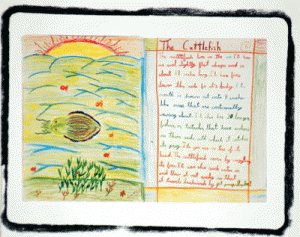In Amy Shultz’s article, “The Sweet Role of Art in
Literacy,” she discusses how teachers can us are and literature in conjunction
to provide visual learners with an access point that can help them learn to
write. She suggests that students create story collages that they can edit,
discuss, and perform for their teachers and classmates. In this project,
students are encouraged to use both images and text to express their ideas,
because this provides them with a way make their ideas visible, even if writing
is still a struggle.
 |
| Here is an Example of a Main Lesson Book from Whole.org |
I am very interested in Shultz’s method of teaching
literacy, and I think to some extent, this was used in my elementary schooling.
I can remember creating “Main Lesson Books” in grades 1-8 in which I was
required to copy stories of my own composition into an artistic book, and
accompany them with visual representations and drawings of important events
within each story. It is very important that teachers avoid creating an
environment where students become frustrated that they cannot read or write. If
we give our visual students an outlet to express their ideas through art, we
can alleviate some of those frustrations. The only challenge with teaching
literacy in this way would be gradually shifting from visual representation to
written literacy with struggling students in order to prepare them for the
rigid assessment requirements often present in public schools for evaluating
literacy. How can we support our visual learners while still meeting mandated test
requirements? Is there a way to change assessment methods in order to evaluate
students based on knowledge and ideas, instead of their ability to write those
ideas on paper?
No comments:
Post a Comment